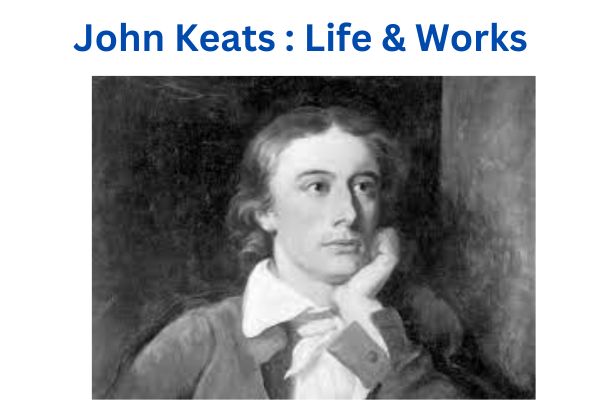John Keats : Life And Works
In the realm of literature, there are poets whose words reach deep into our souls, stirring emotions we never knew we had. John Keats is one such poet. His life was a symphony of passion and pain, reflected in the timeless beauty of his works. Join me as we delve into the life and important works of this remarkable poet, exploring the heartaches and triumphs that shaped his artistry.
A Humble Beginning
John Keats was born on October 31, 1795, in London, England, to humble parents. His father worked as a stable keeper, and his mother passed away when he was just a child. Despite the challenges he faced, Keats possessed a deep love for literature from a young age. His heart was drawn to the beauty of words and the magic they held.
John Keats’s journey began in the heart of London, amid the bustling streets and the whispered struggles of a family acquainted with hardship. Born into modest means, John Keats was no stranger to the weight of poverty’s burden.
His father, a stable keeper, worked tirelessly to provide for his family, but the specter of want was ever present. Tragedy struck early with the loss of Keats’s mother, leaving a tender soul to navigate the world without her guiding light. Yet, in the midst of sorrow, there bloomed a love for literature that would shape Keats’s destiny.
In the quiet corners of their humble home, Keats discovered solace in the pages of books. Each word was a beacon of hope, offering glimpses into realms beyond the confines of his circumstances. Surrounded by the love and resilience of his family, John Keats found the strength to dream, to imagine a life filled with beauty and wonder.
As he matured, Keats’s passion for poetry ignited like a flame in the darkness. He poured his heart into his verses, infusing each line with the raw emotion of his experiences. From the depths of adversity emerged a voice of profound empathy and understanding, a voice that spoke to the universal struggles of the human condition.
In the humble beginnings of John Keats, we witness the resilience of the human spirit – a spirit that refuses to be defined by circumstance, but instead, rises above it, fueled by a fierce determination to carve out a path of beauty and meaning. It is a reminder that greatness knows no bounds, and that even the most modest of beginnings can give rise to a legacy that echoes through the ages.
The Pursuit of Poetry: A Soul’s True Journey
For John Keats, poetry was not just a career path; it was a profound calling that resonated within the depths of his being. From the earliest whispers of his childhood, Keats felt the stirring of a passion that would come to define his existence.
Though apprenticed to a surgeon, Keats’s heart beat to the rhythm of verse, yearning to express the intricacies of human emotion and experience. Each day, the pull of poetry grew stronger, urging Keats to embrace the path laid out before him.
In the silent hours of the night, Keats sought solace in his chamber, where he poured his soul onto the page, crafting verses that mirrored the depths of his innermost thoughts and feelings. Poetry became his sanctuary, a haven where he could unravel the mysteries of life through the power of words.
Yet, the journey of pursuing poetry was fraught with obstacles. Keats faced skepticism and rejection from those who questioned the validity of his chosen path. Despite the doubts that clouded his mind, John Keats remained steadfast in his devotion to his craft. Poetry was not merely a profession for Keats; it was a sacred calling that he could not ignore.
With each poem he penned, Keats delved deeper into the realms of emotion and imagination, channeling his passion into works that resonated with the hearts of readers. Through poetry, Keats found purpose and fulfillment, transcending the challenges of his everyday existence.
In the pursuit of poetry, John Keats unearthed the essence of his soul and discovered a profound connection to the world around him. His words became a beacon of light, illuminating the human experience with their beauty and depth. Through his poetry, Keats left behind a legacy that continues to inspire and move hearts to this day.
Blossoming Talent
In 1816, Keats burst onto the literary scene with his first published poem, “O Solitude.” From that moment on, his star began to rise. His poetry was hailed for its richness of imagery and depth of feeling. With each new work, Keats transported readers to realms of beauty and wonder, inviting them to explore the depths of his imagination.
Love and Loss
But amidst the acclaim, Keats’s life was fraught with sorrow. He experienced the sting of unrequited love and the agony of losing loved ones. The death of his brother Tom, whom he nursed through a long illness, left a profound mark on Keats’s soul. Yet, even in the depths of despair, he found solace in his poetry. It became his sanctuary, a place where he could pour out his heart and find healing in the beauty of words.
Odes of Beauty and Longing
Some of Keats’s most enduring works are his odes, exquisite poems that capture the essence of human experience. In “Ode to a Nightingale,” he grapples with the fleeting nature of joy and the longing for transcendence. In “Ode on a Grecian Urn,” he contemplates the timeless beauty of art and the ephemeral nature of life. Each ode is a masterpiece of emotion, a testament to Keats’s ability to evoke the deepest of feelings with his words.
A Tragic End
Despite his talent and success, Keats’s life was cut tragically short. In 1820, he was diagnosed with tuberculosis, a disease that would claim his life within a year. As his health declined, Keats’s poetic output only intensified. In the face of death, he found a fierce urgency to capture the beauty of life in his verse. His final works are a testament to his courage and resilience in the face of adversity.
Legacy of Beauty and Inspiration
John Keats may have passed from this world at the tender age of 25, but his legacy lives on. His poetry continues to inspire generations of readers, touching hearts with its beauty and depth. Through his words, we are reminded of the power of art to transcend pain and illuminate the human spirit.
In Conclusion
John Keats’s life was a testament to the transformative power of poetry. In his words, we find solace, beauty, and profound truth. Though he may have left this world too soon, his poetry remains a beacon of hope and inspiration for all who seek to glimpse the beauty that lies beyond the veil of tears. As we reflect on his life and works, let us remember John Keats as more than a poet; let us remember him as a soul who dared to dream, to love, and to create beauty in a world touched by sorrow.
Read Also : Unveiling the Timeless Brilliance of Jane Austen: A Literary Journey


1 thought on “John Keats: A Poet’s Journey Through Love and Loss”